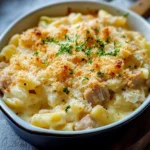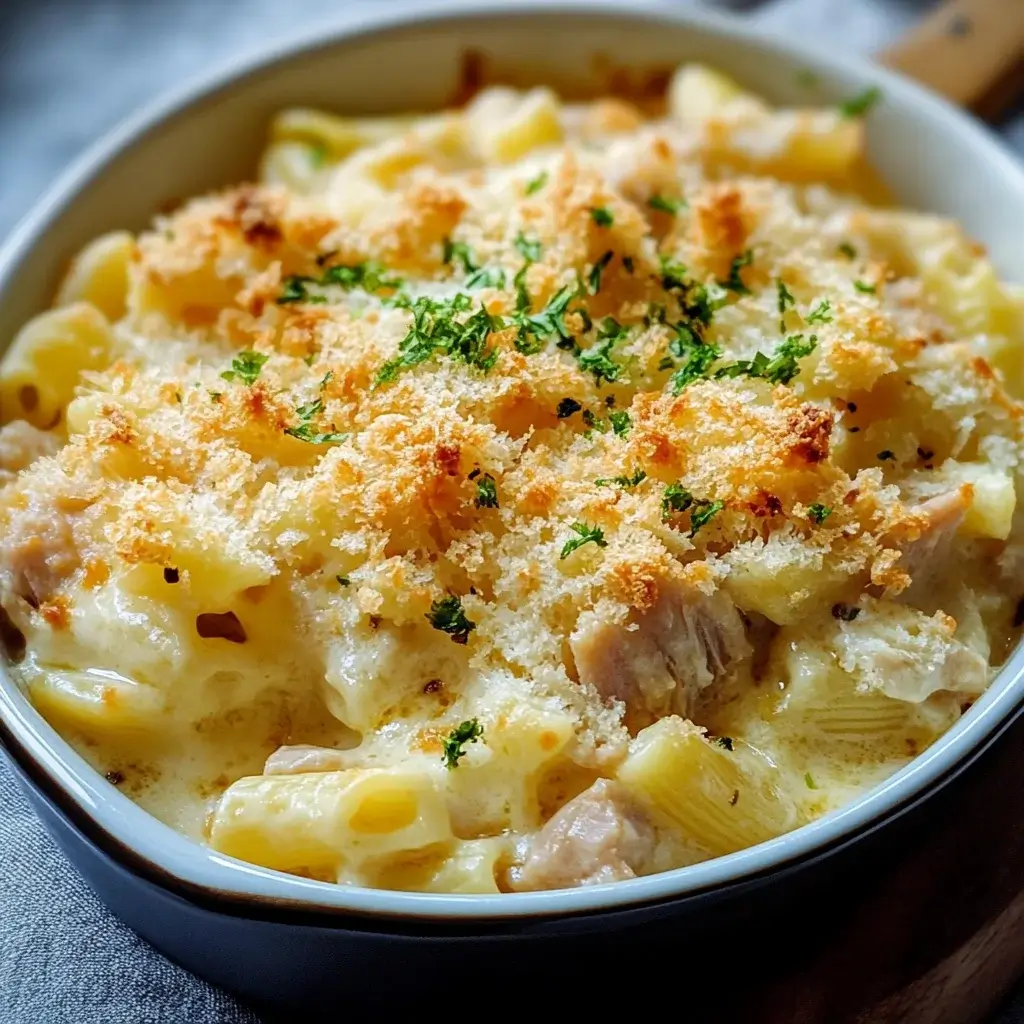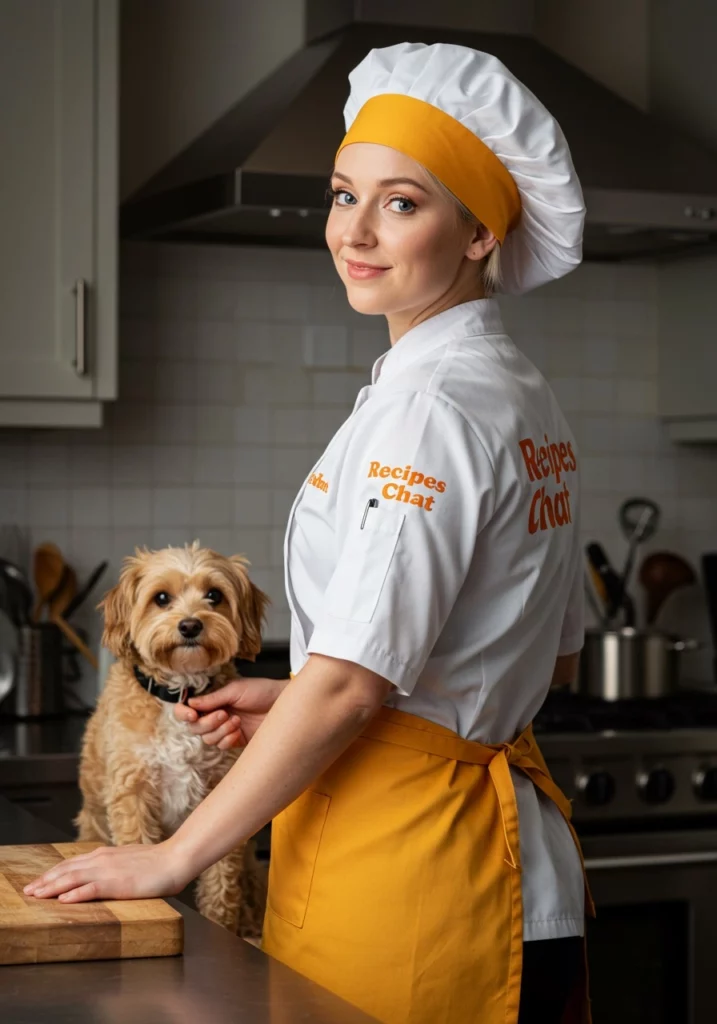It’s funny how some of the simplest recipes can become absolute staples in your household. For us, this Cheesy Tuna Pasta Bake is one of those dishes. Initially, I threw it together on a busy weeknight, needing something quick, comforting, and that I knew even my pickiest eater would enjoy. The result? Empty plates all around and requests for it again the very next week! It’s become our go-to for cozy evenings, potlucks, and even when we just need a bit of cheesy, carb-loaded comfort. The best part is how incredibly versatile it is – you can tweak it with different cheeses, veggies, or even a sprinkle of breadcrumbs for extra crunch. Honestly, if you’re looking for a crowd-pleasing, budget-friendly, and undeniably delicious meal, look no further. This Cheesy Tuna Pasta Bake is a winner every time.
Ingredients
- Pasta: 500g of your favourite pasta shape, such as penne, macaroni, or fusilli. Pasta forms the hearty base of this comforting bake, providing structure and satisfying carbohydrates.
- Tuna: 2 cans (approximately 150g each) of tuna in brine or oil, drained. Tuna adds a wonderful savory flavour and is a great source of protein, making this dish a more complete meal.
- Butter: 50g of unsalted butter. Butter creates a rich base for the sauce and helps to develop flavour as it melts and cooks with the other ingredients.
- Plain Flour: 50g of plain flour. Flour acts as a thickening agent for the white sauce, ensuring it’s creamy and coats the pasta beautifully.
- Milk: 750ml of full-fat milk. Milk is the liquid component of the white sauce, contributing to its creamy texture and diluting the richness of the butter and flour.
- Mature Cheddar Cheese: 250g of mature cheddar cheese, grated, plus extra for topping. Cheddar cheese provides a sharp, savoury, and classic cheesy flavour that complements the tuna perfectly. Mature cheddar offers a stronger flavour than mild cheddar.
- Red Onion: 1 medium red onion, finely chopped. Red onion adds a subtle sweetness and a bit of bite, balancing the richness of the cheese and tuna.
- Frozen Peas: 150g of frozen peas. Peas add a pop of colour, sweetness, and a boost of vitamins to the dish, breaking up the richness and adding textural contrast.
- Dijon Mustard: 1 tbsp of Dijon mustard. Dijon mustard provides a subtle tang and depth of flavour to the white sauce, enhancing the overall taste profile.
- Salt and Black Pepper: To taste. Salt and pepper are essential seasonings that enhance all the other flavours in the dish and ensure it’s well-balanced and delicious.
Instructions
- Preheat the Oven and Cook Pasta: Preheat your oven to 200°C (180°C fan/ Gas Mark 6). While the oven is preheating, get started on the pasta. Fill a large saucepan with salted water and bring to a rolling boil. Add the pasta and cook according to package directions until al dente. ‘Al dente’ means the pasta is cooked through but still has a slight bite to it, preventing it from becoming mushy in the bake. Once cooked, drain the pasta thoroughly and set aside.
- Prepare the White Sauce Base: While the pasta is cooking, prepare the white sauce. In a separate large saucepan, melt the butter over medium heat. Let the butter melt completely and start to gently sizzle. Be careful not to let it brown.
- Create the Roux: Once the butter is melted, add the plain flour to the saucepan. Using a wooden spoon or whisk, stir the flour into the melted butter continuously. This mixture is called a roux. Cook the roux for about 1-2 minutes, stirring constantly. This cooks out the raw flour taste and helps to ensure a smooth sauce. The roux should become a pale, sandy colour.
- Gradually Add Milk: Gradually pour in the milk, a little at a time, whisking continuously after each addition. This is crucial to prevent lumps from forming. Start with just a splash of milk and whisk it in until it’s fully incorporated into the roux. Then, add the milk in larger increments, whisking smoothly each time until the sauce is smooth and lump-free.
- Simmer and Thicken the Sauce: Continue to stir the sauce over medium heat as you add the remaining milk. As you stir, the sauce will start to thicken. Bring the sauce to a gentle simmer, stirring constantly to prevent sticking to the bottom of the pan. Let the sauce simmer for about 3-5 minutes, or until it has thickened to a creamy consistency that coats the back of a spoon. Don’t let it boil vigorously, just a gentle simmer.
- Add Cheese and Mustard: Remove the white sauce from the heat. Stir in the grated cheddar cheese, a handful at a time, until it is completely melted and incorporated into the sauce. The heat of the sauce will melt the cheese beautifully. Next, stir in the Dijon mustard. The mustard adds a subtle tang and depth of flavour to the cheese sauce.
- Sauté the Onion: While making the sauce, in a separate frying pan, melt a little butter or oil over medium heat. Add the finely chopped red onion and sauté for about 5-7 minutes, or until softened and translucent. Sautéing the onion first mellows its flavour and adds a lovely sweetness to the dish.
- Combine Ingredients: Add the drained cooked pasta, flaked tuna, sautéed red onion, and frozen peas to the cheese sauce. Gently stir everything together until all the ingredients are evenly coated in the creamy cheese sauce. Ensure the tuna is broken up into flakes and distributed throughout the mixture.
- Season and Transfer to Baking Dish: Season the mixture generously with salt and black pepper to taste. Taste and adjust seasoning as needed – the cheese and tuna can be salty, so season carefully. Pour the cheesy tuna pasta mixture into a large ovenproof baking dish. A rectangular or oval dish works well.
- Top with Cheese and Bake: Sprinkle the remaining grated cheddar cheese evenly over the top of the pasta bake. This extra cheese topping will melt and create a golden, bubbly crust. Place the baking dish in the preheated oven and bake for 20-25 minutes, or until the top is golden brown and bubbly and the pasta bake is heated through.
- Rest and Serve: Once baked, remove the Cheesy Tuna Pasta Bake from the oven and let it rest for 5-10 minutes before serving. This allows the bake to set slightly and makes it easier to serve. Resting also ensures it’s not too hot to eat immediately. Serve hot and enjoy!
Nutrition Facts
(Per Serving – Serves 6 approximately)
- Calories: Approximately 550 kcal
- Protein: 35g
Please note: Nutritional values are estimates and can vary based on specific ingredients used, brand variations, and portion sizes. For precise nutritional information, use a nutrition calculator with the specific brands and quantities of ingredients you use.
Preparation Time
- Prep Time: 20 minutes – This includes chopping the onion, grating the cheese, preparing the white sauce, and cooking the pasta. The steps are straightforward, making it a relatively quick preparation process.
- Cook Time: 25 minutes – This is the oven baking time, allowing the cheese to melt and the bake to become golden and bubbly.
- Total Time: 45 minutes – From start to finish, this Cheesy Tuna Pasta Bake is ready in under an hour, making it a perfect choice for a weeknight meal.
How to Serve
This Cheesy Tuna Pasta Bake is a complete meal on its own, but you can elevate your dining experience by serving it with complementary sides and garnishes. Here are a few ideas:
- Green Salad: A simple green salad with a light vinaigrette dressing provides a refreshing contrast to the richness of the pasta bake. The acidity of the dressing cuts through the cheese and adds a fresh element.
- Garlic Bread: Crusty garlic bread is a classic accompaniment to pasta dishes. It’s perfect for soaking up any extra cheesy sauce and adds another layer of comforting carbohydrates.
- Steamed Vegetables: Serve with a side of steamed green vegetables like broccoli, green beans, or asparagus. This adds a healthy element and balances the meal with extra vitamins and fiber.
- Tomato Salad: A vibrant tomato salad with fresh basil and a balsamic glaze offers a juicy and tangy counterpoint to the creamy bake. The acidity of tomatoes complements the cheese and tuna.
- Coleslaw: A creamy coleslaw can add a cool and crunchy texture contrast. The slight sweetness and tanginess of coleslaw can also complement the savoury flavours of the bake.
- Crusty Bread Rolls: If garlic bread isn’t your preference, plain crusty bread rolls are still excellent for mopping up the delicious cheese sauce and providing a simple side.
- Lemon Wedges: Offer lemon wedges to squeeze over individual servings. A squeeze of fresh lemon juice brightens the flavours and adds a touch of zest to the rich dish.
- Fresh Herbs: Garnish with fresh parsley or chives, chopped finely, sprinkled over the top just before serving. Fresh herbs add a pop of colour and a fresh, aromatic finish.
Additional Tips for the Perfect Cheesy Tuna Pasta Bake
- Cheese Variety: Don’t be afraid to experiment with different cheeses! While cheddar is classic, try adding a mix of cheeses like Gruyère for nuttiness, mozzarella for stretch, or Parmesan for sharpness. A combination of cheeses can create a more complex and interesting flavour profile. For a smoky flavour, try adding a smoked cheese like smoked cheddar or Gouda.
- Vegetable Boost: Get creative with your vegetables! While peas are standard, you can add other vegetables like sweetcorn, chopped bell peppers (red, yellow, or green for colour), sliced mushrooms, or even some leftover roasted vegetables. Adding vegetables not only boosts the nutritional value but also adds flavour and texture. Sautéing vegetables like peppers and mushrooms before adding them to the sauce enhances their flavour.
- Spice it Up: If you like a bit of heat, add a pinch of red pepper flakes or a dash of hot sauce to the cheese sauce. You could also add a finely chopped chili or a sprinkle of cayenne pepper. This adds a subtle kick that complements the richness of the cheese and tuna without overpowering the dish.
- Breadcrumb Topping: For extra texture and a golden crust, sprinkle breadcrumbs over the cheese topping before baking. Use panko breadcrumbs for extra crunch or regular breadcrumbs mixed with a little melted butter and herbs. You can also add grated Parmesan cheese to the breadcrumbs for extra flavour and browning.
- Herb Infusion: Enhance the flavour of the white sauce by infusing it with herbs. Add a bay leaf to the milk while simmering, or stir in fresh herbs like thyme, parsley, or chives into the sauce at the end. Fresh herbs add a bright and aromatic dimension to the dish. Dried herbs like oregano or mixed herbs can also be added to the sauce while it simmers.
- Tuna Options: While tuna in brine or oil is common, consider using tuna in spring water for a lighter option. For a richer flavour, you can use tuna in olive oil, but ensure you drain it well. You can also use different types of tuna, such as albacore tuna or yellowfin tuna, for variations in flavour and texture. For a flakier texture, gently break up the tuna with a fork before adding it to the sauce.
- Make Ahead Magic: This Cheesy Tuna Pasta Bake is perfect for making ahead of time. Assemble the bake completely, up to the point of baking, and store it, covered, in the refrigerator for up to 24 hours. When ready to bake, add 10-15 minutes to the baking time to ensure it is heated through. This makes it an excellent dish for meal prepping or for entertaining.
- Freezer Friendly: Leftovers of this bake freeze exceptionally well. Allow the baked pasta to cool completely, then portion it into freezer-safe containers. It can be frozen for up to 3 months. To reheat, thaw overnight in the refrigerator and bake in the oven at 180°C (160°C fan/ Gas Mark 4) until heated through and bubbly, usually around 30-40 minutes. You can also reheat individual portions in the microwave for a quick lunch.
Frequently Asked Questions (FAQ)
Q1: Can I use different types of pasta for this bake?
A: Absolutely! While penne, macaroni, and fusilli are popular choices because their shapes hold the sauce well, you can use other pasta shapes like rigatoni, shells, or even farfalle (bow-tie pasta). Just ensure you cook the pasta al dente as per the package instructions, as it will continue to cook in the oven during baking. Short pasta shapes are generally preferred for bakes, as they distribute more evenly within the sauce.
Q2: I don’t have red onion, can I use a different type of onion?
A: Yes, you can substitute red onion with other types of onions. Yellow or white onions are excellent alternatives. Yellow onions will provide a more classic onion flavour, while white onions are slightly sharper. You could also use shallots for a milder and sweeter flavour. Remember to sauté any type of onion before adding it to the pasta bake to soften its flavour and texture.
Q3: Can I make this recipe vegetarian?
A: To make this recipe vegetarian, simply omit the tuna. You can add other protein sources like cooked lentils, chickpeas, or cannellini beans to make it more substantial. Alternatively, you could increase the amount of vegetables, adding ingredients like roasted vegetables (courgette, aubergine, peppers) or sautéed mushrooms to create a flavourful vegetarian pasta bake. Consider adding a vegetarian cheese that melts well to maintain the cheesy element.
Q4: What can I use instead of full-fat milk for the white sauce?
A: While full-fat milk provides the richest and creamiest sauce, you can use semi-skimmed milk or even skimmed milk as lighter alternatives. The sauce will be slightly less rich, but still delicious. For a dairy-free option, you can use plant-based milk like oat milk or unsweetened almond milk. Oat milk is particularly good for creamy sauces. You may need to simmer the sauce for a little longer to thicken it if using lower-fat or plant-based milks.
Q5: How do I prevent the white sauce from being lumpy?
A: The key to a smooth white sauce is to add the milk gradually and whisk continuously. Make sure you cook the roux (butter and flour mixture) for a minute or two before adding the milk to cook out the raw flour taste. Start by adding just a splash of milk and whisking it in thoroughly before adding more. Whisk constantly as you add the milk and while the sauce is simmering to prevent lumps from forming. If lumps do occur, you can try passing the sauce through a fine-mesh sieve to remove them.
Q6: Can I add a crispy topping to the pasta bake?
A: Yes, adding a crispy topping is a great way to enhance the texture of the pasta bake. As mentioned in the tips, breadcrumbs are an excellent choice. Mix breadcrumbs with melted butter, grated Parmesan cheese, and herbs for extra flavour and crunch. Sprinkle this mixture over the cheese topping before baking. You could also use crushed crackers, potato chips, or even fried onions for different crispy topping variations.
Q7: How long will leftovers last in the refrigerator?
A: Leftover Cheesy Tuna Pasta Bake can be stored in an airtight container in the refrigerator for up to 3-4 days. Ensure it is cooled completely before refrigerating. When reheating, ensure it is heated through to a safe internal temperature. Reheat in the oven for best results to maintain the texture, or microwave for a quicker option.
Q8: Can I use fresh tuna instead of canned tuna?
A: While canned tuna is most commonly used for this recipe for convenience and cost-effectiveness, you could use fresh tuna if you prefer. Cook fresh tuna steaks by grilling, pan-frying, or baking them until cooked through and flaky. Flake the cooked tuna and add it to the pasta bake as you would canned tuna. Fresh tuna will offer a different flavour profile and texture, being less processed than canned tuna. Ensure fresh tuna is cooked to a safe internal temperature before adding it to the bake.
Print
Cheesy Tuna Pasta Bake
Ingredients
- Pasta: 500g of your favourite pasta shape, such as penne, macaroni, or fusilli. Pasta forms the hearty base of this comforting bake, providing structure and satisfying carbohydrates.
- Tuna: 2 cans (approximately 150g each) of tuna in brine or oil, drained. Tuna adds a wonderful savory flavour and is a great source of protein, making this dish a more complete meal.
- Butter: 50g of unsalted butter. Butter creates a rich base for the sauce and helps to develop flavour as it melts and cooks with the other ingredients.
- Plain Flour: 50g of plain flour. Flour acts as a thickening agent for the white sauce, ensuring it’s creamy and coats the pasta beautifully.
- Milk: 750ml of full-fat milk. Milk is the liquid component of the white sauce, contributing to its creamy texture and diluting the richness of the butter and flour.
- Mature Cheddar Cheese: 250g of mature cheddar cheese, grated, plus extra for topping. Cheddar cheese provides a sharp, savoury, and classic cheesy flavour that complements the tuna perfectly. Mature cheddar offers a stronger flavour than mild cheddar.
- Red Onion: 1 medium red onion, finely chopped. Red onion adds a subtle sweetness and a bit of bite, balancing the richness of the cheese and tuna.
- Frozen Peas: 150g of frozen peas. Peas add a pop of colour, sweetness, and a boost of vitamins to the dish, breaking up the richness and adding textural contrast.
- Dijon Mustard: 1 tbsp of Dijon mustard. Dijon mustard provides a subtle tang and depth of flavour to the white sauce, enhancing the overall taste profile.
- Salt and Black Pepper: To taste. Salt and pepper are essential seasonings that enhance all the other flavours in the dish and ensure it’s well-balanced and delicious.
Instructions
- Preheat the Oven and Cook Pasta: Preheat your oven to 200°C (180°C fan/ Gas Mark 6). While the oven is preheating, get started on the pasta. Fill a large saucepan with salted water and bring to a rolling boil. Add the pasta and cook according to package directions until al dente. ‘Al dente’ means the pasta is cooked through but still has a slight bite to it, preventing it from becoming mushy in the bake. Once cooked, drain the pasta thoroughly and set aside.
- Prepare the White Sauce Base: While the pasta is cooking, prepare the white sauce. In a separate large saucepan, melt the butter over medium heat. Let the butter melt completely and start to gently sizzle. Be careful not to let it brown.
- Create the Roux: Once the butter is melted, add the plain flour to the saucepan. Using a wooden spoon or whisk, stir the flour into the melted butter continuously. This mixture is called a roux. Cook the roux for about 1-2 minutes, stirring constantly. This cooks out the raw flour taste and helps to ensure a smooth sauce. The roux should become a pale, sandy colour.
- Gradually Add Milk: Gradually pour in the milk, a little at a time, whisking continuously after each addition. This is crucial to prevent lumps from forming. Start with just a splash of milk and whisk it in until it’s fully incorporated into the roux. Then, add the milk in larger increments, whisking smoothly each time until the sauce is smooth and lump-free.
- Simmer and Thicken the Sauce: Continue to stir the sauce over medium heat as you add the remaining milk. As you stir, the sauce will start to thicken. Bring the sauce to a gentle simmer, stirring constantly to prevent sticking to the bottom of the pan. Let the sauce simmer for about 3-5 minutes, or until it has thickened to a creamy consistency that coats the back of a spoon. Don’t let it boil vigorously, just a gentle simmer.
- Add Cheese and Mustard: Remove the white sauce from the heat. Stir in the grated cheddar cheese, a handful at a time, until it is completely melted and incorporated into the sauce. The heat of the sauce will melt the cheese beautifully. Next, stir in the Dijon mustard. The mustard adds a subtle tang and depth of flavour to the cheese sauce.
- Sauté the Onion: While making the sauce, in a separate frying pan, melt a little butter or oil over medium heat. Add the finely chopped red onion and sauté for about 5-7 minutes, or until softened and translucent. Sautéing the onion first mellows its flavour and adds a lovely sweetness to the dish.
- Combine Ingredients: Add the drained cooked pasta, flaked tuna, sautéed red onion, and frozen peas to the cheese sauce. Gently stir everything together until all the ingredients are evenly coated in the creamy cheese sauce. Ensure the tuna is broken up into flakes and distributed throughout the mixture.
- Season and Transfer to Baking Dish: Season the mixture generously with salt and black pepper to taste. Taste and adjust seasoning as needed – the cheese and tuna can be salty, so season carefully. Pour the cheesy tuna pasta mixture into a large ovenproof baking dish. A rectangular or oval dish works well.
- Top with Cheese and Bake: Sprinkle the remaining grated cheddar cheese evenly over the top of the pasta bake. This extra cheese topping will melt and create a golden, bubbly crust. Place the baking dish in the preheated oven and bake for 20-25 minutes, or until the top is golden brown and bubbly and the pasta bake is heated through.
- Rest and Serve: Once baked, remove the Cheesy Tuna Pasta Bake from the oven and let it rest for 5-10 minutes before serving. This allows the bake to set slightly and makes it easier to serve. Resting also ensures it’s not too hot to eat immediately. Serve hot and enjoy!
Nutrition
- Serving Size: one normal portion
- Calories: 550
- Protein: 35g



